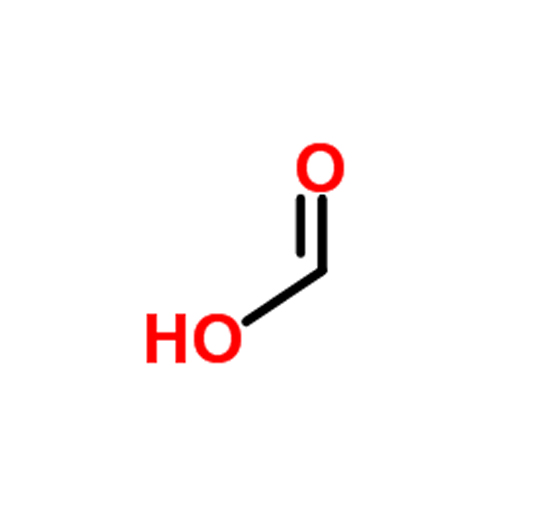
Formic Acid (HCOOH) is a colorless, volatile liquid that is the simplest carboxylic acid. It is naturally present in the sting of ants and in the secretion of certain insects. Formic acid is widely used as a preservative and antibacterial agent in the food industry, as well as a feed additive for livestock. It is also used in the production of dyes, plastics, and rubber and as a cleaning agent in the leather and textile industries. Formic acid has a strong, pungent odor and is highly corrosive and toxic. It should be handled with care and used only in well-ventilated areas with appropriate protective measures in place.
TOPFINE FINE CHEMICALS is a leading formic acid supplier and manufacturer in China. If you require high-quality formic acid products, please contact us directly and get the latest formic acid prices.
| item+a37:d60 | Standard | ||
| Appearance | Colorless Transparent Liquid | Colorless Transparent Liquid | Colorless Transparent Liquid |
| Formic Acid Content%≥ | 85 | 90 | 94 |
| Chloride Content%≤ | 0.006 | 0.002 | 0.002 |
| Sylphate Content%≤ | 0.02 | 0.005 | 0.005 |
| Lron Content%≤ | 0.0006 | 0.0006 | 0.0006 |
| Evaporation Residue%≤ | 0.06 | 0.02 | 0.02 |
| Cas No | 64-18-6 | ||
| Molecular Formula | Ch2o2 | ||
| Molecular Weight | 46.03 |
Pharmaceutical industry: caffeine, analgin, aminopyrine, aminophylline, theobromine borneol, vitamin B1, metronidazole, and mebendazole.
Pesticide industry: triadimefon, triadimefon, tricyclazole, triazophos, paclobutrazol, Uniconazole, insecticide, dicofol, etc.
Chemical industry: calcium formate, sodium formate, ammonium formate, potassium formate, ethyl formate, barium formate, dimethylformamide, formamide, rubber antioxidant, pentaerythritol, neopentyl glycol, epoxy soybean oil, epoxy octyl soybean oleate, tervaleryl chloride, paint remover, phenolic resin, pickling steel plate, etc.
Leather industry: tanning agent, deliming agent and neutralizer of leather.
Rubber industry: natural rubber coagulant.
Others: It can also manufacture printing and dyeing mordant, dyeing agent, treatment agent, plasticizer, food preservation and animal feed additive for fiber and paper.
Make CO. Chemical formula: HCOOH=(concentrated H2SO4 catalysis) heating=CO+H2O
Reducing agent. Determination of arsenic, bismuth, aluminum, copper, gold, indium, iron, lead, manganese, mercury, molybdenum, silver and zinc. Determination of cerium, rhenium and tungsten. Examine aromatic primary and secondary amines. Solvent for determination of relative molecular weight and crystallization. Determination of methoxy. Used as fixative in microanalysis. Manufacture of formates.
Formic acid and its aqueous solution can dissolve many metals, metal oxides, hydroxides and salts, and the formate generated can be dissolved in water, so it can be used as a chemical cleaning agent. Formic acid does not contain chloride ions and can be used for cleaning equipment containing stainless steel materials.
Evaporation residue is flammable. It is freely miscible with water, ethanol, ether and glycerin, and is miscible with most polar organic solvents. It is also soluble in hydrocarbons. The relative density (d204) is 1.220. The combustion heat is 254.4 kJ/mol, the critical temperature is 306.8 ℃, and the critical pressure is 8.63 MPa. Flash point 68.9 ℃ (open cup). Density: 1.22, relative vapor density: 1.59 (air=1).
Formic acid with high concentration tends to freeze in winter.
Incompatibility: strong oxidant, strong alkali, active metal powder.
Hazard characteristics: Its vapor and air form an explosive mixture, which can cause combustion and explosion in case of open fire and high heat. It can react with strong oxidants.
Solubility: miscible with water, insoluble in hydrocarbons, miscible in alcohol.
Location:
Cool, dry, well-ventilated area.
Away from heat, flames, and sunlight.
Containers:
Use stainless steel, polyethylene, or glass.
Keep tightly sealed and labeled.
Avoid:
Strong oxidizers, bases, and reducing agents.
Metals like aluminum, iron, and zinc.
Ventilation:
Ensure good ventilation to prevent vapor buildup.
PPE:
Wear gloves, goggles, and lab coats.
Have emergency eye wash and showers nearby.
Spills:
Use spill containment and cleanup materials.
Neutralize with dilute sodium bicarbonate.
Temperature:
Store below 25°C (77°F).
Fire Safety:
Keep fire extinguishers nearby.
Do not use water to extinguish fires.
Follow these guidelines to ensure safe storage and handling of formic acid.
3 / F, South Tower,1# Building, No.456 North Fute Road, Pudong New District, Shanghai 200131, China



021-5858-9995
 English
English 中文
中文